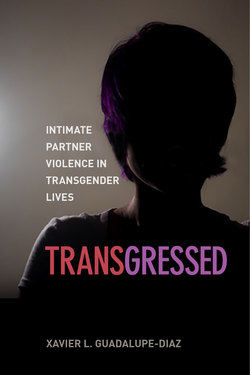Читать книгу Transgressed - Xavier L. Guadalupe-Diaz - Страница 8
На сайте Литреса книга снята с продажи.
Developing the Project
ОглавлениеAs is the case with many research ideas, my journey toward a trans-centered project on intimate partner violence came about in gradual stages. As a scholar exploring the field, I quickly learned how divisive and contentious the debate over the role of gender in intimate partner violence had been and began questioning some basic assumptions. For instance, do men and women commit equal acts of violence toward one another, or are men the dominate abusers? Meanwhile, I grew more and more interested in the deeper complications of gender—beyond this binary system—to explore how gender informed violence structurally and through interaction.
Today, advocates and scholars alike find that different types of intimate partner violence result in different gendered dynamics. As sociologist Michael P. Johnson generally argued, perhaps the intense coercion that more women experience in intimate partner violence at the hands of men requires the structural power of patriarchy, while more common violence between partners may arise in less patterned and inherently gendered ways.14 As a queer-identified individual, however, I understood that gender could be experienced more dynamically and in less static ways than commonly conceptualized in the intimate partner violence literature. That is to say that for many individuals, gender identity may conflict with assigned labels or can be understood as more of a journey of evolution and self-discovery. I questioned how a type of violence in which gender informs aggression, communication, identity, and interaction is experienced by those who identify outside of the rigid gender binary, which represents a cultural system of two institutionally legitimized genders. Scholars often refer to that cultural system of two genders as genderism—“a social system of structural inequality with an underlying assumption that there are two, and only two genders.”15 I utilize the term “genderism” here and throughout to describe the structural, institutional, interpersonal, and intrapersonal systems that marginalize, subordinate, and threaten gender variance for individuals who identify as transgender, which includes those who are genderqueer, gender-nonconforming, gender-nonbinary, and/or otherwise gender variant.16 Further, genderism characterizes a cultural ideology “that reinforces the negative evaluation of gender non-conformity or an incongruence between sex and gender.”17 While transphobia describes fear or disgust against transgender people, genderist ideology more broadly describes how culture regulates the boundaries of appropriate gender expression and identification.18 In setting up a research endeavor to answer that initial question, I started by first taking stock of what we already knew, in particular, how scholars had come to understand the role of gender and other identities within intimate partner violence.
